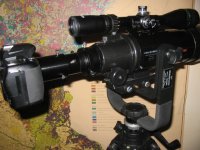jeepnut
Active member
The CA-35 camera adapter is well respected, but f12.5 for the PF80 and PF100-ED (f12 for the PF65 and PF65-ED II) scopes reduces it to bright light photography.
Can anyone explain why the CA-35 "pushes" (doubles) the focal length of the scopes? A camera adapter that matches the focal length of the scopes would be of great utility and in my mind should be optically superior.
I would like to see Pentax introduce a new camera adapter that approximates focal length of the scopes at f6 with pricing comparable to XF eyepieces.
--jeepnut
Can anyone explain why the CA-35 "pushes" (doubles) the focal length of the scopes? A camera adapter that matches the focal length of the scopes would be of great utility and in my mind should be optically superior.
I would like to see Pentax introduce a new camera adapter that approximates focal length of the scopes at f6 with pricing comparable to XF eyepieces.
--jeepnut





